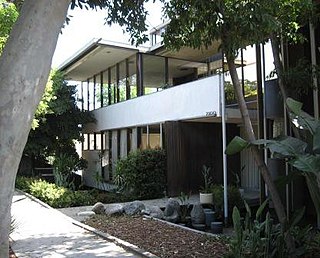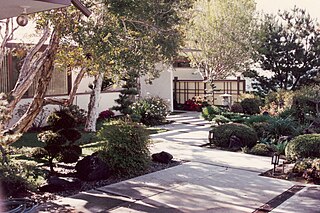The Cliff May Experimental House was built by Cliff May in the early 1950s as his family's fourth house and developed to push his ideas of "bringing the outdoors in" and open interior planning. The one-story, 1800-sf house is a simple rectangle in plan with a 288-square foot open skylight in the center. May's family of five created different rooms by using movable partitions. The family resided in the home for two years, while May determined how the sizeable skylight and open plan functioned for the residents there. From this experience, the home "Mandalay" was designed by May, which became the last home for his family.
This house is located at 1831 Old Ranch Road in the Riviera Ranch neighborhood of Los Angeles. [1] The house is located behind a locked gate and is not publicly accessible. Thomas D. Church & Associates, Landscape Architects. Peggy Galloway, Interior Designer. It was recognized as a City of Los Angeles Historic Cultural Landmark in 2002. In 2007, design firm Marmol Radziner restored the historic home, re-establishing the open floor plan, replacing the roof, and bringing the home up to current code. [2] The firm also provided landscape design and interior design services.

The Eames House is a landmark of mid-20th century modern architecture located at 203 North Chautauqua Boulevard in the Pacific Palisades neighborhood of Los Angeles. It was constructed in 1949, by husband-and-wife design pioneers Charles and Ray Eames, to serve as their home and studio. The house is also known as Case Study House No. 8 because it was commissioned by Arts & Architecture magazine as part of a program challenging architects to design progressive, but modest, homes in Southern California. Charles and Ray moved into the home on Christmas Eve in 1949 and never moved out. Charles's daughter, Lucia Eames, inherited the home and created the non-profit organization, the Eames Foundation, in 2004. Still a historic house museum maintained by the Eames Foundation, it was designated a National Historic Landmark in 2006 and serves as a pilgrimage site for nearly 20,000 visitors a year.

Ranch is a domestic architectural style that originated in the United States. The ranch-style house is noted for its long, close-to-the-ground profile, and wide open layout. The style fused modernist ideas and styles with notions of the American Western period of wide open spaces to create a very informal and casual living style. While the original ranch style was informal and basic in design, ranch-style houses built in the United States from around the early 1960s increasingly had more dramatic features such as varying roof lines, cathedral ceilings, sunken living rooms, and extensive landscaping and grounds.

John Edward Lautner was an American architect. Following an apprenticeship in the mid-1930s with Frank Lloyd Wright, Lautner opened his own practice in 1938, where he worked for the remainder of his career. Lautner practiced primarily in California, and the majority of his works were residential. Lautner is perhaps best remembered for his contribution to the development of the Googie style, as well as for several Atomic Age houses he designed in the late 1950s and early 1960s, which include the Leonard Malin House, Paul Sheats House, and Russ Garcia House.

The Olmsted Brothers company was a landscape architectural firm in the United States, established in 1898 by brothers John Charles Olmsted (1852–1920) and Frederick Law Olmsted Jr. (1870–1957), sons of the landscape architect Frederick Law Olmsted.

The Third Street Promenade is a pedestrian mall esplanade, shopping, dining and entertainment complex in the downtown area of Santa Monica, California which originally opened as the Santa Monica Mall on November 8, 1965. It is considered a premier shopping and dining district on the Westside and draws crowds from all over the Greater Los Angeles area. Due to easy access to Downtown Los Angeles via the Big Blue Bus rapid transit service, E Line's terminus station and the Pacific Coast Highway-Santa Monica Freeway Interstate, the neighborhood's north-south thoroughfares connecting to Muscle Beach, Venice Canal Historic District, Marina del Rey, Ballona Wetlands and Los Angeles International Airport, and its proximity to historic U.S. Route 66, Santa Monica Pier, Palisades Park, Tongva Park, Santa Monica State Beach and the Pacific Ocean coupled with Los Angeles's mild mediterranean climate, it is also a popular tourist destination.

The Schindler House, also known as the Schindler Chace House or Kings Road House, is a house in West Hollywood, California, designed by architect Rudolph M. Schindler.

Stiles Oliver Clements was an architect practicing in Los Angeles and Southern California.
Woodbury University is a private university in Burbank, California, with a satellite campus in San Diego.
Rustic Canyon is a residential neighborhood and canyon in eastern Pacific Palisades, on the west side of Los Angeles, California. It is along Rustic Creek, in the Santa Monica Mountains.

Barnsdall Art Park is a city park located in the East Hollywood district of Los Angeles, California. Parking and arts buildings access is from Hollywood Boulevard on the park's north side. The park is a Los Angeles Historic-Cultural Monument, and a facility of the City of Los Angeles Department of Cultural Affairs.

The Helms Bakery on the border of Los Angeles and Culver City, California was a notable industrial bakery of Southern California that operated from 1931 to 1969. The buildings have now been adapted for reuse as retail shops, restaurants and the interior design trade showrooms and the complex is part of what is now called the Helms Bakery District.

Cliff May (1903–1989) was an architect practicing in California best known and remembered for developing the suburban Post-war "dream home", and the Mid-century Modern.

Neutra VDL Studio and Residences, the home of architect Richard Neutra, is located in Los Angeles, California. It is also known as the Neutra Research House, the Van der Leeuw House, the Richard and Dion Neutra VDL Research House II, or the Richard and Dion Neutra VDL Research Houses and Studio. It was designed by Richard Neutra and his son Dion Neutra. The house is currently owned by California State Polytechnic University, Pomona, and is maintained by its College of Environmental Design. The property was added to the National Register of Historic Places in 2009, and was designated as a National Historic Landmark in 2016.
The USC School of Architecture (USCArchitecture) is the architecture school at the University of Southern California. Located in Los Angeles, California, it is one of university's 17 professional schools, offering both undergraduate and graduate degrees in the fields of architecture, building science, landscape architecture and heritage conservation.

The Clark House is an International-Modernist Style residence designed by American Modernist architect Richard Neutra, and built in 1957 in Pasadena, California, United States.
The Kronish House is a 7,000 square foot villa designed by Richard Neutra in 1955. The house is located on 9439 Sunset Boulevard in Beverly Hills, California in the United States. The house was designed for Herbert and Hazel Kronish.
The Garcia House is a private home in the Hollywood Hills of Los Angeles, designed by architect John Lautner. Located on Mulholland Drive, it sits on stilts 60 feet above the canyon below. Also known as the "Rainbow House" for its parabolic roof over stained glass windows and a curved ceiling that rises to 30 feet in height, it has been described as "one of the 10 most important residences from the midcentury period in Los Angeles."

Cerro Pelon Ranch is a large ranch estate in Santa Fe County, New Mexico. About thirty Hollywood productions have been filmed there, including Silverado, Lonesome Dove, Wild Wild West, 3:10 to Yuma, and Thor. The film set originally constructed on the property for Silverado has been expanded and revised for each succeeding production. Contrasting the old-fashioned appearance of these sets, the property is also noted for ultramodern houses and facilities built there after its purchase in 2001 by fashion designer Tom Ford. These include a horse facility designed by noted architect Tadao Ando and implemented by the architecture firm of Marmol Radziner as executive architect and general contractor of the project, and a number of other buildings and facilities designed and built by Marmol Radziner.
Marmol Radziner is a design-build practice based in Los Angeles that was founded in 1989 by American architects Leo Marmol and Ron Radziner. The firm specializes in residential, commercial, hospitality, cultural, and community projects, and offers various design services, including architectural design, construction, landscape design, interior design, furniture design, jewelry design, and modern architecture restoration.

Ron Radziner is an American architect who is the co-founder and design partner of the design-build practice, Marmol Radziner.
Coordinates: 34°04′05″N118°30′13″W / 34.067932°N 118.503700°W